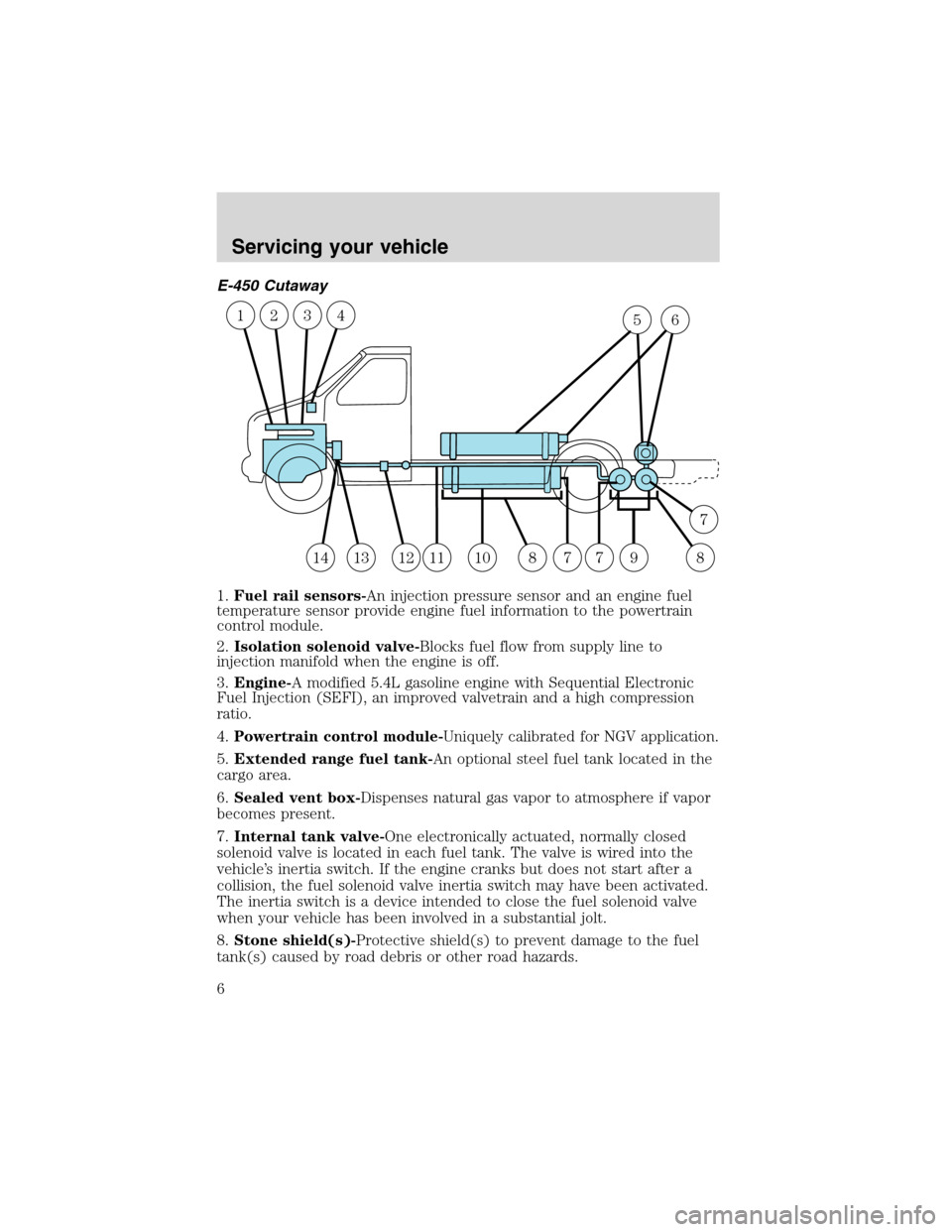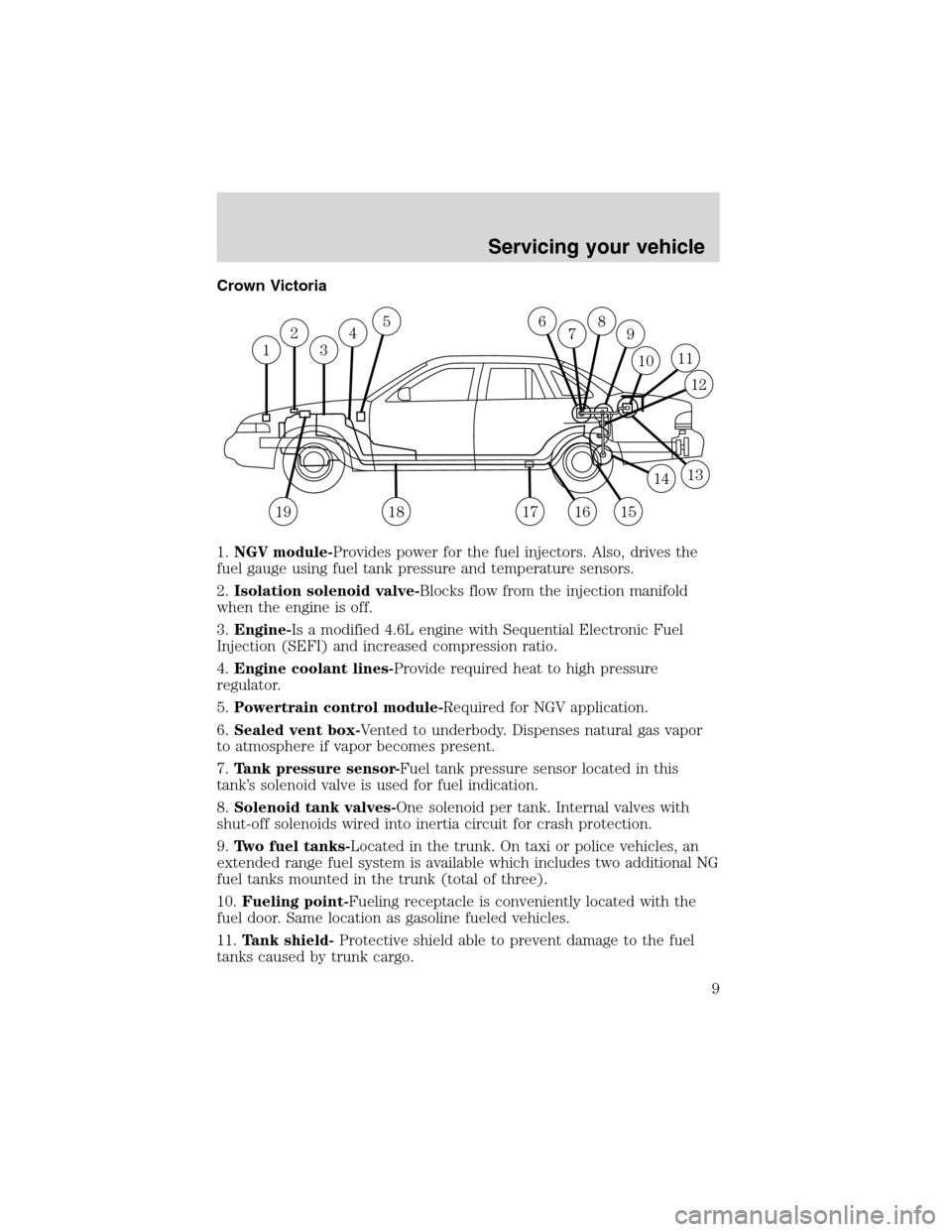lock FORD E SERIES 2003 4.G Natural Gas Vehicle Supplement Manual
[x] Cancel search | Manufacturer: FORD, Model Year: 2003, Model line: E SERIES, Model: FORD E SERIES 2003 4.GPages: 16, PDF Size: 0.08 MB
Page 6 of 16

E-450 Cutaway
1.Fuel rail sensors-An injection pressure sensor and an engine fuel
temperature sensor provide engine fuel information to the powertrain
control module.
2.Isolation solenoid valve-Blocks fuel flow from supply line to
injection manifold when the engine is off.
3.Engine-A modified 5.4L gasoline engine with Sequential Electronic
Fuel Injection (SEFI), an improved valvetrain and a high compression
ratio.
4.Powertrain control module-Uniquely calibrated for NGV application.
5.Extended range fuel tank-An optional steel fuel tank located in the
cargo area.
6.Sealed vent box-Dispenses natural gas vapor to atmosphere if vapor
becomes present.
7.Internal tank valve-One electronically actuated, normally closed
solenoid valve is located in each fuel tank. The valve is wired into the
vehicle’s inertia switch. If the engine cranks but does not start after a
collision, the fuel solenoid valve inertia switch may have been activated.
The inertia switch is a device intended to close the fuel solenoid valve
when your vehicle has been involved in a substantial jolt.
8.Stone shield(s)-Protective shield(s) to prevent damage to the fuel
tank(s) caused by road debris or other road hazards.
13
321456
1114101298877
7
Servicing your vehicle
6
Page 7 of 16

9.Aft axle fuel tanks-Two steel fuel tanks located behind the rear axle.
10.Midship fuel tank-A steel fuel tank located underbody.
11.High pressure fuel lines-Delivers high pressure fuel to the fuel
tanks and fuel pressure regulator.
12.Fuel pressure regulator/Coalescent fuel filter-Reduces fuel
pressure to 95 psi and removes impurities from the gas.
13.Low pressure fuel line-Supplies 95 psi of natural gas to the
injectors.
14.NGV module-Contains the unique powertrain electronics that are
required for an NGV.
F-Series Pick-up
1.Fuel rail sensors-An injection pressure sensor and an engine fuel
temperature sensor provide engine fuel information to the powertrain
control module.
2.Isolation solenoid valve-Blocks flow from supply line to injection
manifold when the engine is off.
3.Engine-A modified 5.4L gasoline engine with Sequential Electronic
Fuel Injection (SEFI), an improved valvetrain and a high compression
ratio.
12
324156
109811
6b
7
5
Servicing your vehicle
7
Page 9 of 16

Crown Victoria
1.NGV module-Provides power for the fuel injectors. Also, drives the
fuel gauge using fuel tank pressure and temperature sensors.
2.Isolation solenoid valve-Blocks flow from the injection manifold
when the engine is off.
3.Engine-Is a modified 4.6L engine with Sequential Electronic Fuel
Injection (SEFI) and increased compression ratio.
4.Engine coolant lines-Provide required heat to high pressure
regulator.
5.Powertrain control module-Required for NGV application.
6.Sealed vent box-Vented to underbody. Dispenses natural gas vapor
to atmosphere if vapor becomes present.
7.Tank pressure sensor-Fuel tank pressure sensor located in this
tank’s solenoid valve is used for fuel indication.
8.Solenoid tank valves-One solenoid per tank. Internal valves with
shut-off solenoids wired into inertia circuit for crash protection.
9.Two fuel tanks-Located in the trunk. On taxi or police vehicles, an
extended range fuel system is available which includes two additional NG
fuel tanks mounted in the trunk (total of three).
10.Fueling point-Fueling receptacle is conveniently located with the
fuel door. Same location as gasoline fueled vehicles.
11.Tank shield-Protective shield able to prevent damage to the fuel
tanks caused by trunk cargo.
13
2456879
10
12
11
1413
1516171819
Servicing your vehicle
9